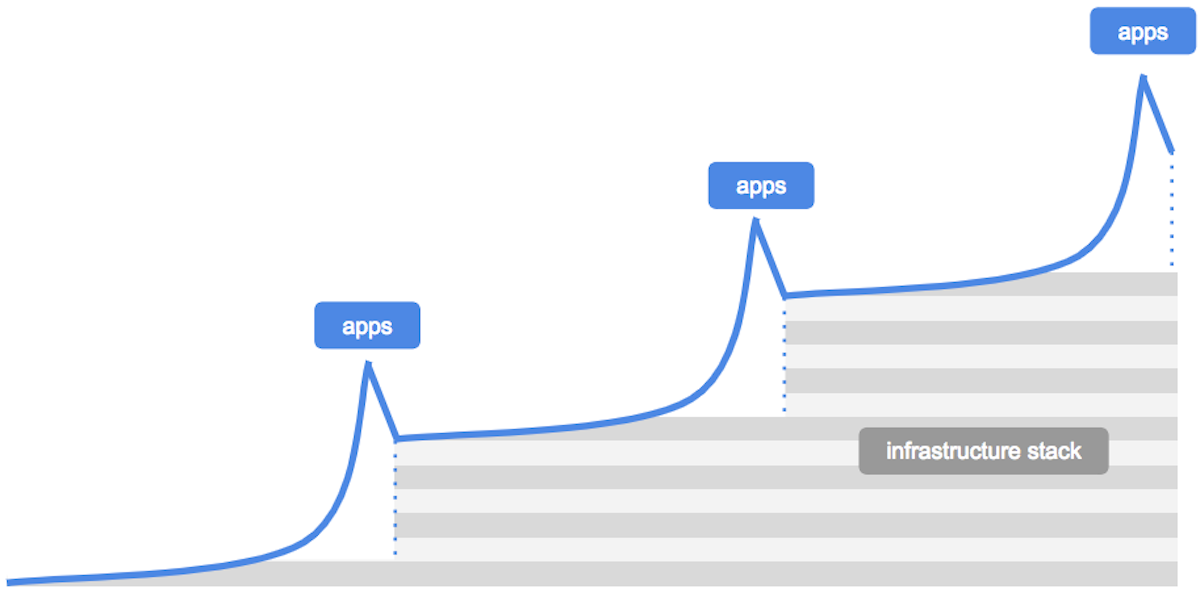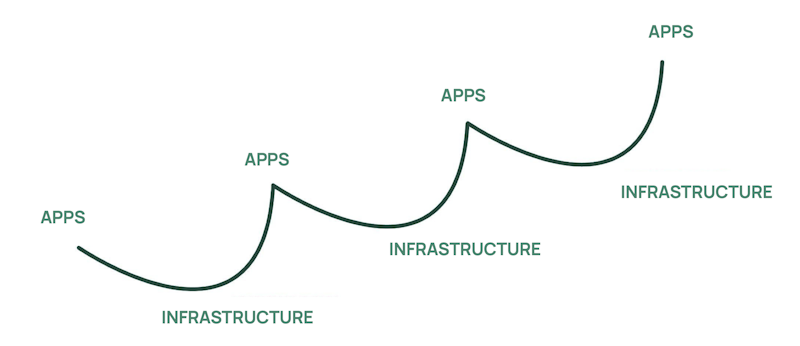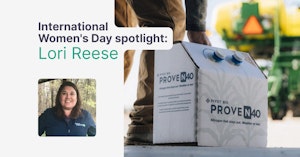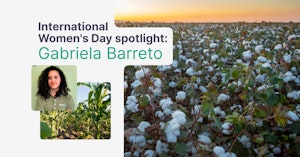This is an exciting time to be working in Agtech because we are at the start of a new cycle of applications and infrastructure. Over the last 40 years Agtech has advanced from basic technologies like yield mapping and crop recordkeeping to more advanced applications like carbon marketplaces, autonomous machinery, and data driven agronomy. Now, with the infrastructure built in the previous cycle, these new applications are being developed and are able to successfully scale. This will in turn inspire the next wave of infrastructure to support ever more valuable applications.
As we think about the current state and future of technology in agriculture, we often reference Dani Grant and Nick Grossman from Union Square Ventures (USV)’s thoughts on the relationship between applications and infrastructure. Understanding how one affects the other gives us a better perspective of how to build for the future of Agtech.
First, what is infrastructure?
In the physical world, infrastructure means things like bridges and power lines, and that infrastructure powers applications like cars and lightbulbs. In the digital world the concept of infrastructure as tools to enable applications is the same, but instead of physical things, digital infrastructure means tools like APIs, databases, and computing services. This digital infrastructure powers applications like Airbnb, Facebook, or Uber.
Digital infrastructure can also mean higher level services that in turn enable higher level applications. Stripe is an example of an infrastructure company that uses lower level infrastructure tools like cloud computing combined with their deep expertise to build and provide online payments infrastructure that is used by internet companies to power their online stores.
Apps -> Infrastructure cycle
In their 2018 article, The Myth of the Infrastructure Phase</a, Dani Grant and Nick Grossman explain how the history of new technologies shows that apps drive the need for infrastructure and not the other way around.
Their examples include the light bulb (the app), which was invented in 1879, and preceded the electric grid (the infrastructure), implemented in 1882. Likewise, the airplane (the app), was invented before there were airports (the infrastructure) in 1928: “the breakout app that is an airplane came first in 1903, and inspired a phase where people built airlines in 1919, airports in 1928 and air traffic control in 1930 only after there were planes.”
“First, apps inspire infrastructure. Then that infrastructure enables new apps.”
- Grant & Grossman

They also argue that apps and infrastructure evolve in responsive cycles instead of separate phases:
“What we see in the sequence of events of major platform shifts is that first there is a breakout app, and then that breakout app inspires a phase where we build infrastructure that makes it easier to build similar apps, and infrastructure that allows the broad consumer adoption of those apps.” - Grant & Grossman

To highlight how these cycles play out over time, Grant and Grossman give an example of the apps -> infrastructure cycle of the internet:
“We start with the first apps: messaging (1970) and email (1972), which then inspire infrastructure that makes it easier to have broad consumer adoption of messaging and email: Ethernet (1973), TCP/IP (1973), and Internet Service Providers (1974). Then there is the next wave of apps, which are web portals (Prodigy in 1990, AOL in 1991), and web portals inspire us to build infrastructure (search engines and web browsers in the early 1990’s). Then there is the next wave of apps, which are early sites like Amazon.com in 1994, which leads to a phase where we build infrastructure like programming languages (PHP in 1994, Javascript and Java in 1995) that make it easier to build websites… And the cycle continues.”

What does the apps-infrastructure cycle look like in Agtech?
The concept of apps-infrastructure cycles is useful for understanding how new applications came to be and why some application ideas that didn’t work previously become massively successful a decade later. We can apply this same framework to agtech’s progression to uncover useful lessons about how applications have developed and trends of what the future may hold for apps and infrastructure in agriculture.
Apps & Infrastructure in Agtech
Joseph Russo with Precision Ag highlights four evolutionary phases in Agtech from the 1980’s to 2010’s that can help us begin to shape the Agtech apps to infrastructure cycle. Starting in the 1980’s, agricultural technology was focused on adapting technologies such as the personal computer, GIS and GPS for agriculture. These resulted in the first Agtech applications including yield mapping, crop recordkeeping, and remote sensing. In turn, these applications inspired new infrastructure like more accurate GPS units, yield monitors, and agricultural software programs. This infrastructure then paved the way for new applications, mostly related to precision agriculture, including variable rate seeding, crop scouting apps, and guidance lines.
As David Mulla and Raj Khosla note in their study of the Historical Evolution and Recent Advances in Precision Farming, these early app/infrastructure cycles were key in advancing the industry: “The addition of GPS to farm equipment enabled many other technological breakthroughs in precision farming, such as autosteer, and furthermore, machine location was essential for variable rate fertilizer application technology.”
After these early cycles, the next cycles led to new applications like Farm Management Systems (FMS/FMIS), agronomy software, and profit tracking. These applications continued the trend of not only collecting data but also building on top of existing data and services. These more sophisticated applications quickly demanded an infrastructure cycle including IoT hardware, higher resolution imagery, supply chain digitization, and higher level software development tools like Leaf.
Now we’re seeing the next wave of applications use the latest infrastructure to build new products like carbon marketplaces, agfintech products, and machine autonomy.

Reflecting on this cycle in Agtech leads to new questions:
- Are there examples of agriculture application ideas that didn’t work a decade ago that are working today or could work today because of better infrastructure?
- What other applications can now be built with existing infrastructure?
- What new technologies will the next cycle of apps and infrastructure in agriculture bring?
The apps-infrastructure cycle gives us a better framework when assessing the present state and future of Agtech.
Where are we in the
Agtech apps -> infrastructure cycle?
Looking at the up and coming applications in the industry there is a clear and consistent trend of using existing data and services to unlock new value. To do this, companies are using the existing infrastructure like yield monitors and wireless data transfer that were built in previous cycles, together with new infrastructure, like Leaf’s unified farm data API, to support ever more sophisticated applications.
We believe that we are at the start of a new apps->infrastructure cycle because these new breakout applications are offering entirely new categories of products to their customers and relying on the latest infrastructure to do so.
New applications and even new categories like fintech for ag, machine autonomy, carbon tracking & markets, data-enabled biotech, sustainability, and digital retail are now being built and driving the industry forward. Looking into a few of these categories shows us how different these new applications are and why they indicate the start of a new cycle.
-
Fintech for agriculture Companies like Arbol are using existing data and services to create new value like parametric insurance products. Grower's Edge is another example that offers data-backed crop management plan guarantees, while others offer entirely new models, like outcome based pricing as an alternative to operating loans.
-
Digital retail and agronomic services Hutchinsons, a retail and agronomy services provider for the past 80+ years is now using existing infrastructure to to evolve their precision agronomy, retail, and sustainability services in the United Kingdom with OMNIAs, an application for farm nutrient management. Growmark is an example of a cooperative that is building their own digital ecosystem for their members to access real-time, personalized services.
-
Carbon & sustainability Carbon tracking companies like CIBO are building sophisticated applications that require significant infrastructure to function. The models tracking carbon offset and inset require ingesting years of management and environmental data from a variety of proprietary data sources and measuring, then continuously verifying the carbon captured. Ellingson Companies is a construction company that launched a digital platform to help their customers track and share the sustainability metrics and ROI of irrigation projects.
Building these applications requires solving a series of daunting technical challenges like secure data access, file translation, data cleaning, and field boundary reconciliation in addition to building the core product. By leveraging infrastructure companies to manage these and other challenges for them, those developing applications can focus on the core differentiating features of their product.
It is possible for companies to build all of this infrastructure for their applications internally, just as it is possible for companies to build their own databases and CRM internally, but it is more likely that the winners in the next application cycle will leverage existing, public infrastructure tools like AWS/Azure/GCP (processing, storage, etc.) and Leaf (farm data translation, field boundary management, platform compatibility, etc.) as a part of their tech stack so they can focus their efforts on building their core product.
As industry specific infrastructure and general infrastructure continue to advance, the companies building these new categories of applications will enjoy an ever strengthening tailwind that will help them to continue to deliver increasing value to their customers. This is an exciting time to be working in Agtech because companies are using the strong base of existing farm data and powerful, publicly available infrastructure to build new applications and even new categories of applications.
What will you build?
The apps leading this new cycle are still early in their development and distribution and as they grow and succeed they will certainly inspire and demand the next levels of infrastructure which will in turn power the next wave of Agtech apps. We’re inspired by the idea that as more technology is built for the agriculture industry these cycles will accelerate and produce an increasing amount of new value for farmers, consumers, land owners, and every company in the supply chain. We think this is an important and likely outcome but it will take significant talent and effort throughout the industry to realize.
Leaf's mission is to help companies build the future of agriculture by providing intuitive, powerful tools so that developers can focus on their core applications and deliver value to their customers.
Leaf's unified API helps Agtech companies become instantly compatible with all major agriculture data sources so they can focus their full effort on building valuable applications for their customers while Leaf’s team manages the complicated and time-consuming challenges of data integration, file translation, standardization, and ongoing integration maintenance.
If you would like to learn more about Leaf, please find product information here and register for an account here.
If you're interested in joining our team, please visit our careers page.
A special thanks to Ted Macy and Terry Griffin, PhD with Griffin Consulting LLC for their valuable expertise and contributions to this article.





